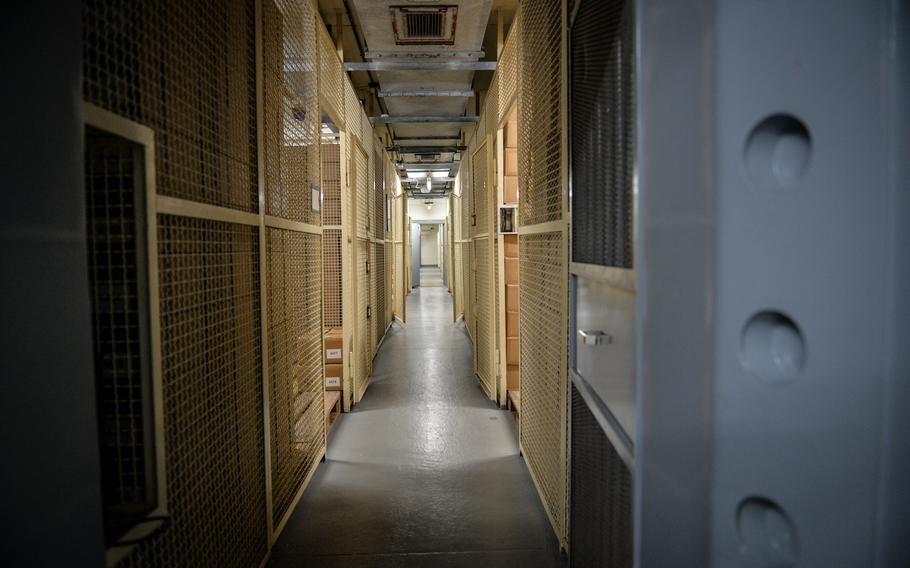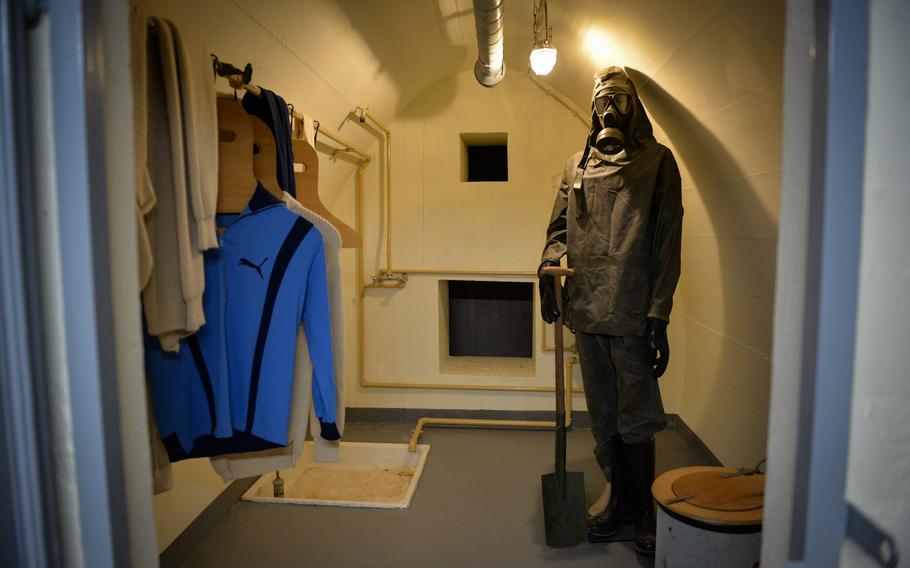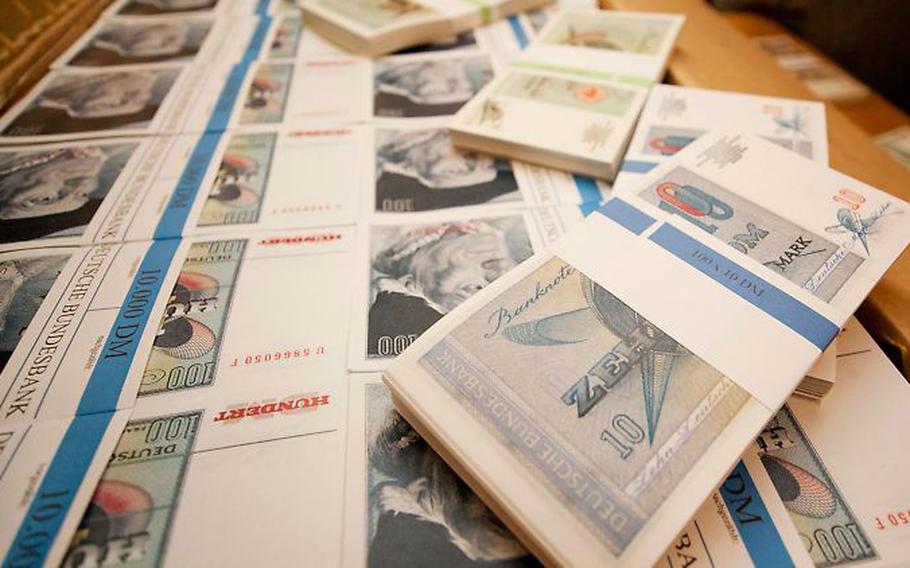
Martin Moonsen leads a tour at the former secret bunker of the German federal bank in Cochem, Germany, March 4, 2023. The bunker was intended to shelter Germany's wartime reserve currency from nuclear blasts and natural disasters. (Alexander Riedel/Special to Stripes)
A house with a basement vault full of money sounds like the storyline lifted from the pages of comics featuring Scrooge McDuck.
In the German riverside town of Cochem, however, more than half of the country’s currency reserves were once stored beneath residential homes. The Cold War nuclear bunker of the Bundesbank, Germany’s federal reserve, was a long-kept secret.
Seven years ago, the bunker was transformed into a museum open to the public. It seemed like a perfect activity on a cold and cloudy day.
There is no parking, so a shuttle brings visitors from downtown to the museum. We walked instead and after about 20 minutes, we arrived at a concrete-and-glass entrance at the end of a hillside cul-de-sac.
Before we entered the bunker, our tour guide, Martin Moonsen, pointed out the building next door.

Two houses on a quiet street in Cochem, Germany, once housed the secret entrance to the underground bunker complex of Germany’s federal bank. Today, the buildings are home to Hotel Vintage. (Alexander Riedel/Special to Stripes)
Behind the ordinary facade of the building was the original bunker entrance, Moonsen revealed. The camouflage was so effective that the buildings were never suspected of harboring billions in what might be one of the world’s most unusual basements.
To explain the heavy foot traffic at the site until its closure in 1993, the government designated it the official training and recreation home of the Bundesbank. The bunker itself was accessed via a secret tunnel from inside the house.
Visitors today can stay in the former camouflaged buildings at “Hotel Vintage,” which maintains the site as a bed and breakfast. But why was it once necessary to hide money in this sleepy neighborhood?

Reserve currency was once stacked floor-to-ceiling and frequently counted by select examiners of Germany's federal bank to ensure accountability while in storage in Cochem, Germany. (Alexander Riedel/Special to Stripes)
During World War II, Nazi agents planned to influence the British pound with fake currency created in forced labor camps. Operation Bernhard was intended to cripple the United Kingdom’s wartime economy by devaluing British cash reserves.
“Without trust in your currency, you can’t do business,” Moonsen explained. “That can be very destabilizing very quickly.”
Fearing similar threats from the Eastern Bloc during the Cold War, West German planners wanted to be able to replace a weakened German mark quickly in case the country were flooded with counterfeit money.
Should the public lose faith in the validity of the marks in their wallets, the federal reserve would have rolled out all-new Bundesbank-Series II bills.

Germany's reserve currency was once stored in large stacks and stored in a secret humidity-controlled underground vault room in Cochem, Germany. After the bunker closed in 1988, the currency, which was never released, was completely destroyed. (Alexander Riedel/Special to Stripes)
In the meantime, Germany need a secure location for the reserves of “BBK II.” One fear was the looming threat of nuclear attack.
“This location along the Moselle seemed particularly protected (from attack),” Moonsen said. “One thought that a possible atomic pressure wave during the Cold War would simply sweep across the deep river valley.”
Cochem’s proximity to the Bundesbank headquarters in Frankfurt and the West German capital, Bonn, also was deemed ideal for the reserve cache.
Construction of the bunker began in 1960 and was completed in 1965, costing what would be almost $99 million today.

The vault room in the former federal bank bunker in Cochem, Germany, once housed thousands of boxes containing an alternate wartime currency for Germany. (Alexander Riedel/Special to Stripes)
When residents complained about the construction noise, they were they told that the structure was an air raid shelter they would be able to use in case of war.
“This was not uncommon during the time, as many shelters were built during those days,” Moonsen said.
Starting in 1965, the federal bank began transporting freshly printed bills via hundreds of truck deliveries, arriving slowly over nearly a decade. Once filled, the vault stored about 15 billion marks for more than two decades.
Downstairs, visitors enter the airlocked corridor through blast-proof metal doors. A decontamination chamber, equipped with a mannequin in full protection gear, highlights the drab vision of the doomsday scenario the bunker was prepared for: a nuclear attack on Germany.

A decontamination chamber at the former federal bank bunker site in Cochem, Germany, was once intended to allow new entries to the site to wash off fallout contamination after traveling to the bunker after a nuclear attack. (Alexander Riedel/Special to Stripes)
At the heart of the museum is a large, tubular vault. Unlike the treasure in Scrooge McDuck’s money chamber, however, this one had no coins or gold bars to dive into.
It was all paper money in various denominations, stacked floor to ceiling in shipment-ready boxes in a humidity-controlled underground chamber.
Only replica boxes now remain to show visitors the extent of the stash, while imitations of the BBK-II replacement series can be bought as souvenirs.

Examples of German wartime replacement currency are on display at the former German Federal Bank Bunker in Cochem, Germany. The currency was intended to replace cash in case of an influx of fake currency during a war. (Bundesbank Bunker Cochem)
Despite the riches stashed away here, the money was usually not guarded by more than three men of the site management and custodial staff so as to not arouse suspicion, Moonsen said.
Until official release, the alternative bills weren’t valid anyway.
“The only keys to the vault door, which weighs several tons, were kept at the Bundesbank headquarters in Frankfurt,” Moonsen said. “If there was even a false alarm, the authorized staff had to travel from Frankfurt to check on the facility.”

Visitors exit the vault room at the former federal bank bunker March 4, 2023, in Cochem, Germany. The heavy steel-reinforced doors once shielded 15 billion German marks of replacement currency from theft, natural disaster and nuclear attack. (Alexander Riedel/Special to Stripes)
As electronic finance and security requirements changed over the decades, reserve currency plans were abandoned.
By the time the Berlin Wall fell in 1989 and long before the arrival of the euro, all money in the bunker had been removed and destroyed, leaving an almost untouched historical site vacant.
After nearly an hour perusing the vault, our tour group emerged into the daylight. The hills of Cochem provided a wonderful view of the town and the Moselle River before we headed home.

The footpath toward the Bundesbank Bunker Museum gives visitors a great view over Cochem, Germany. During the summer season, the museum can also be reached via shuttle bus from downtown. (Alexander Riedel/Special to Stripes)
On the QT
Address: Am Wald 35, Cochem, Germany
Hours: The bunker must be visited as part of a tour. During the summer months, from April 1 to Nov. 1, tours are available once per hour from 11 a.m. to 3 p.m. During the winter, tours are limited to 11 a.m., 1 p.m. and 5 p.m.
Cost: German language tours through the facility start at 13 euros per adult and 7 euros for children under 17. Pre-booked English group tours are available for a 30-euro additional fee.
Information: bundesbank-bunker.de/en